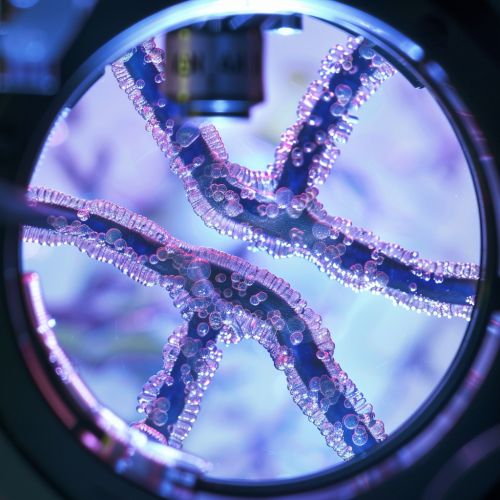Chromosome theory of inheritance
Introduction
The Chromosome theory of inheritance is a fundamental principle in biology that explains how genetic information is transmitted from one generation to the next. It postulates that genes, the units of heredity, are located on chromosomes. This theory was first proposed by Walter Sutton and Theodor Boveri in the early 20th century, independently of each other.
Historical Background
The chromosome theory of inheritance was developed in the early 20th century, following the rediscovery of Mendel's laws of inheritance. This theory was primarily the work of two scientists, Walter Sutton and Theodor Boveri, who independently arrived at similar conclusions about the role of chromosomes in heredity. Their work built upon the findings of other scientists, such as August Weismann, who had proposed that the nucleus was the site of heredity, and Edouard Van Beneden, who had observed the behavior of chromosomes during cell division.


Chromosomes and Genes
Chromosomes are long, thread-like structures located within the nucleus of both animal and plant cells. Each chromosome is made of protein and a single molecule of DNA. Genes are segments of DNA located on chromosomes. Each gene holds an instruction code that is used to assemble protein molecules, which direct the body's cells to function and reproduce.
Mendelian Inheritance and Chromosomes
The chromosome theory of inheritance incorporates the laws of inheritance proposed by Gregor Mendel. Mendel's laws, which include the law of segregation and the law of independent assortment, can be explained by the behavior of chromosomes during meiosis, the process of cell division that produces sex cells.
Law of Segregation
The Mendelian law of segregation states that an organism's characteristics are determined by the pair of alleles it possesses, which are separated and randomly distributed to the sex cells during meiosis. This can be explained by the behavior of homologous chromosomes, which are pairs of chromosomes containing the same genes. During meiosis, these homologous chromosomes separate, with each sex cell receiving one chromosome from each pair.
Law of Independent Assortment
The Mendelian law of independent assortment states that the alleles for different characteristics are distributed to sex cells independently. This can be explained by the behavior of chromosomes during meiosis. The independent alignment and separation of homologous chromosomes during meiosis leads to the independent assortment of genes located on different chromosomes.
Evidence for the Chromosome Theory of Inheritance
The chromosome theory of inheritance was supported by several lines of evidence. One of the earliest pieces of evidence came from the work of Thomas Hunt Morgan, who conducted breeding experiments with fruit flies. Morgan's work showed that genes are arranged linearly on chromosomes and that genes located on the same chromosome are often inherited together, a phenomenon known as genetic linkage.
Genetic Linkage and Recombination
Genetic linkage is the tendency of genes that are located close together on the same chromosome to be inherited together. The discovery of genetic linkage was a major support for the chromosome theory of inheritance. However, it was also observed that linked genes can be separated through a process called recombination, which occurs during meiosis. Recombination results in new combinations of genes, providing further support for the chromosome theory of inheritance.
Modern Understanding of the Chromosome Theory of Inheritance
Today, the chromosome theory of inheritance is a cornerstone of genetics. It has been expanded and refined with the discovery of the structure of DNA and the development of molecular genetics. It is now understood that genes are specific sequences of nucleotides in DNA that code for proteins, and that the location of a gene on a chromosome can affect its expression, a concept known as gene regulation.
